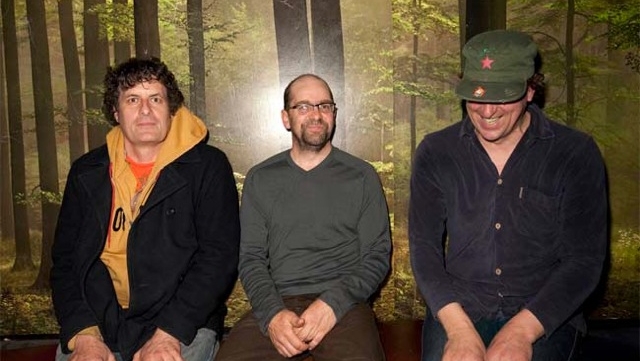Pixel Mountain has been created in collaboration with artists from Korea; in brief, it’s a performance involving dance, aerial performance, interactive digital projection and architecture. “Pixel Mountain marries architecture, humanity and digital technology, we cover those three grounds,” explains Clarkson. “We use 3D image, audio technology, and aerial interactive projection, and perform on iconic buildings.” Stalker Theatre has long been creating its distinctive style of innovative and interactive physical performance. Pixel Mountain expresses notions about human beings and the technological environment in a 30-minute work where interactive 3D image responds to movements of aerialists performing on the side of a building. PixelMountain was first performed in 2013 at Korea’s Gwacheon Festival and at the Hi Seoul Festival.
“At the High Seoul Festival we performed on the side of the Seoul Museum of Art,” continues Clarkson. “In Melbourne we’ll be performing it on a structure made of shipping containers. It looks at where we are in terms of relationship, at virtual space and the politics of space, of society occupying virtual space and virtual worlds. These are indicators of our future. Where we are humankind, with industrialisation, increasingly the body becomes less and less important and the human soul, humanity is lost. Pixel Mountainis a reflection on all our futures. We look at South Korea as an interesting example of modernity – it’s rapidly gone from the bottom to the top of OECD list. Korean society employs the highest use of technology and is now experiencing the markers of modernity – suicide, social alienation, workaholism, industrialisation. There’s been such a rapid change, it’s been so fast, yet they still have a ‘traditional mountain village people’ mentality. The sense of community is one of the beauties of Seoul. It’s one of the world’s biggest cities, leaders in modern technology, yet there are feeling of connection and community. You see it in fact, always around food, for example, which is always shared. People eat together as a group. They work together in a practical sense, there’s a connection with each other.”
In terms of a cultural exchange, as an Australian-Korean collaboration Pixel Mountain satisfies Clarkson’s ideas of hitting true notes when it comes to artistic understanding. “With work across other cultures we wish to have a resonance with local artists. Pixel Mountain is an interesting kind of critique of Korean culture; aiming to develop both the Australian and the Korean art form. Our biggest benchmark is expressed in comments from our Korean Assistant Director (Ji-Hyun Lee) who says, ‘You really understand the Korean aesthetic, the Korean way of working.’ We set up a collaboration which was open artistically. One element of Korean culture is included in the work, around the idea of ritual female suicide. There’s a moment in the work where we look at that darkness. Korea has one of the highest OECD ratings but the widest gap is between male and female income. It has been a tradition in Korea where women, when they had no voice to express oppression or concerns, would express that by taking their own lives and two of the Korean dancers wanted to have that aspect included; it’s the darkest aspect of the performance but they wanted that in the show. It’s hidden by the poetical nature of the show but we’re able to get those elements in the work.”
Westerners may make the mistake of assuming that arts practice in newly industrialised cultures is dominated by tradition but this isn’t the case. “Korea is outward looking in developing its own artistic practice; it’s not scared to look to the world, to collaborate, to push the boundaries and experiment with form. It’s definitely part of the excitement of exchange.”
Clarkson notes that although Pixel Mountain is a charged political work, it delivers its message through pure visual and physical poetry. “The work isn’t didactic; it’s a poetical work of movement which reflects on social markers in a visual physical form. I like my work to be popular but not necessarily populist. It’s a fairly intuitive, anti-narrative in a sense; it’s understood as a visceral response to the work. Over the last several years I’ve worked on developing a visual aesthetic around technology and physicality.”
One challenge for Clarkson in presenting Pixel Mountain was in finding a performance space; there just wasn’t a suitable wall in the vicinity. “We are adapting it to the site; we’re building one out of shipping containers.” This means that the performers can’t rehearse in [on] the space but it’s a problem that is happily addressed by technology the team is already using, something punters will also get to enjoy after the performance. “We will create a 3D map of the container. At the end of show we make a play space for the audience to get up on stage and play with interaction – something we haven’t done before.”
BY LIZA DEZFOULI
